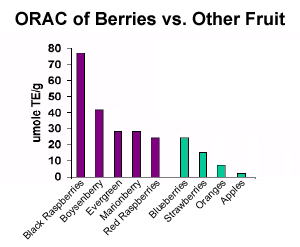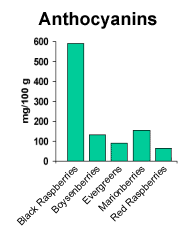|
HEALTH
Berries are a powerhouse
of good things. They carry antioxidants, vitamins and minerals
that help the body prevent cancer and keep the mind energized.
The following is a more detailed description of the health
benefits of our berries.
Black Raspberries
What is known to scientific fact is that damage by oxygen
free radicals is a contributing factor in many of the problems
associated with aging, particularly cardiovascular disease
and cancer. Oxygen free radicals attack DNA, causing cell
mutation that in turn prevents natural cell death. Antioxidants,
such as ORAC, have an innate ability to seek and destroy
oxygen free radicals. This is why foods that have high ORAC
values, such as the potent black raspberry, are so essential
to a healthy daily diet.
Generally speaking, dark-colored berries are naturally
high in flavonoids and phenolics (such as anthocyanins and
ellagic acid, making them strong antioxidants. This is particularly
true in the case of black raspberries -- they contain almost
twice the amount of phenolic content found in other berries.
Studying the natural chemopreventive properties of black
raspberries, Dr. Gary Stoner of Ohio State University reported
findings that may support a food-based approach to cancer
prevention. In the study, freeze-dried black raspberries
inhibited colon cancer by about 50 percent when added to
the diets of rodents that has been chemically treated with
carcinogens. This study is an extension of earlier research
in which freeze-dried strawberries and black raspberries
prevented carcinogen-induced esophageal cancer in rodents
by 50-70 percent.
Red Raspberries
New research now suggests that by eating red raspberries
a person may prevent cancer. Tests conducted at the Hollings
Cancer Center at the Medical University of South Carolina
have revealed that the human body readily absorbs the ellagic
acid from red raspberries, thus inhibiting the abnormal
division of cells and promoting the normal death of healthy
cells. This ellagic acid has been clinically shown to cause
apoptosis (cell death) in certain cancer cells.
Among several significant phytochemicals, red raspberries
contain ellagic acid, a phenolic compound that has exhibited
anti-carcinogenic effects against a wide range of carcinogens
in several tissues. Ellagic acid contributes to significant
inhibition of colon, esophageal, liver, lung, tongue, and
skin cancers in studies with rats and mice, both in vitro
and in vivo. By the same token, quercetin, one of the flavanols
found in raspberries, has been found to be an effective
anticarcinogen against skin, colon, and mammary cancers
in rodents. Anthocyanins are also prevalent in red raspberries,
working as antioxidants that protect against heart disease
and age-related mental decline.
What is interesting to note is the superior efficacy of
eating red raspberries as opposed to taking the individual
phytochemicals in the form of dietary supplements. Although
it is not understood as why this is so, it is clear the
nutraceutical whole is greater than the sum of its parts.
ORAC
ORAC (Oxygen Radical Absorbency Capacity) values are a
measure of the antioxidant activity. Specifically, it measures
the degree and length of time it takes to inhibit the action
of an oxidizing agent. Antioxidants inhibit oxidation which
is known to have a damaging effect on tissues. Studies now
suggest that consuming fruits and vegetables with a high
ORAC value may slow the aging process in both body and brain.
Antioxidants are shown to work best when combined; the presence
of fiber and other plant compounds enhance the health benefit.
For this reason, a nutraceutical source is a more viable
antioxidant option than that of a dietary supplement.

Phytochemicals
Salicylic Acid
The salicylic acid found in Oregon cane berries may prove
to have the same protective effect against heart disease
as aspirin. Aspirin is a closely related compound known
to pharmacists as salicylic acid acetate. The therapeutic
successes of small daily doses of aspirin to inhibit atherosclerosis
suggest the possibility that salicylic acid consumed in
foods may provide a similar benefit. A 100-gram serving
(about 3/4 cup) of red raspberries contains around 5 milligrams
of salicylic acid.
Quercetin
A flavonol that works as an anti-carcinogen and an antioxidant,
quercetin has also been shown to reduce the release of histamine
and may be effective against allergies. The quercetin content
of Oregon caneberries (known to date) is as follows: red
raspberries, 12 milligrams per 100 grams of juice (about
3/8 cup) and Evergreen blackberries, 0.5-3.5 milligrams
per 100 grams of fruit (about 3/4 cup).
Vitamin C
Also known as ascorbic acid, Vitamin C is a water-soluble
nutrient that functions as an antioxidant. Like the antioxidant
phytochemicals, Vitamin C 'sponges up' free radicals to
keep them from doing harm.
Catechins
Catechins are flavonols that support the antioxidant defense
system. Catechins found in caneberries are very similar
to those found in green tea which studies show may contribute
to cancer prevention. The catechins content found in 100
grams (about 3/4 cup) is as follows: red raspberries, .83
milligrams and Evergreen blackberries, 1.4 milligrams.
Fiber
A carbohydrate-like substance found only in plants. Dietary
fiber helps maintain a healthy gastrointestinal tract and
may help prevent certain types of cancers. It can also help
to reduce blood cholesterol levels and lower the risk of
heart disease.
Ellagic Acid
Ellagic acid is a member of the family of phenolic compounds,
which are known to influence the quality, acceptability
and stability of foods by acting as flavorants, colorants,
or antioxidants. It is a substance that appears to block
various hormone reactions and metabolic pathways associated
with the development of cancer. Ellagic acid is exceptionally
high in raspberries and blackberries; the levels are approximately
five to six times higher than those levels found in some
other fruits.
Anthocyanin
Antioxidant characteristics associated with berries can
be attributed to the anthocyanin content. Anthocyanins,
which act as pigments to give berries their deep color,
are a major component of the phenolic/flavonoid class. Recent
research documents anythocyanins acting as an antioxidant,
providing many potential health benefits. Researchers are
currently linking anthocyanin activity to improving vision,
controlling diabetes, improving circulation, preventing
cancer, and retarding the effects of aging, particularly
loss of memory and motor skills.

|





